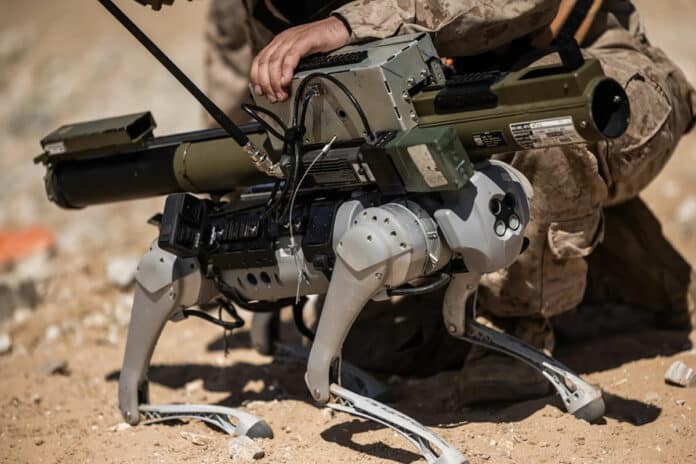Robotic dogs are fascinating creatures that can walk, run, jump, balance on uneven surfaces, and even sit on their hind legs. Equipped with various sensors and capabilities, it can navigate complex terrains and perform tasks such as inspection, mapping, delivery, surveillance, and exploration. However, some people also have a strange desire to equip them with sniper rifles and other weapons.
A quadruped robotic platform referred to as the “robotic goat” equipped with a light anti-tank weapon on the back was tested at the US Marine Corps Air Ground Combat Center in California last September. A rocket launcher was strapped to the back of a commercially available robotic goat as part of a tactical training exercise.
Marines with Tactical Training and Exercise Control Group (TTECG), Marine Air Ground Task Force Training Command, Marine Corps Air Ground Combat Center (MCAGCC), in concert with the Office of Naval Research (ONR) test, fired an M72 Light Anti-tank Weapon (LAW) rocket launcher from the robotic goat.
The robotic goat can carry various sensors or weapon systems that would otherwise be carried by a Marine. The test offers a glimpse into how a small robot could support a soldier in a number of tasks, including engagements with armored vehicles.
The M72 LAW has been a part of the US military arsenal since 1963 and is a standard tool of infantry battalions. Weighing only 5.5 pounds, the weapon is lightweight and very easy to fire. It is also cheap enough to be discarded after firing, making it a popular choice among military personnel. According to a Marine Corps guide, any Marine with basic infantry skills can fire the weapon, and it is not specific to any particular line of service.
The rockets fired by the launcher can travel up to 1,000 meters (3,300 feet) but are most effective at a range of around 200 meters (660 feet). However, this puts the person trying to destroy the tank dangerously close to the tank’s big cannon and any machine guns it may have for self-defense. This risk is higher for armies fighting in open fields, but the M72 LAW was specifically designed for the density and obstructions of urban combat.
All these features, from simplicity to disposability to close-range firing, make it a suitable weapon to attach to a remote-controlled robot shooter, increasing a force’s capability while keeping humans safe from harm.
“Instead of having a Marine handle the weapon system, manipulate the safeties, we could put a remote trigger mechanism on it that allowed it to all be done remotely,” said 1st Lt. Aaron Safadi, officer in charge of emerging technology integration section, TTECG, in the press release. “The Marine could be behind cover and concealment, the weapon system could go forward, and the Marine could manipulate the safeties from a safe place while allowing that weapon system to get closer to its target.”
The robot goat used by the Marines to test the M72 is simply a tool for testing purposes and not intended for carrying it into combat.
Testing emerging technologies, such as robotics, aligns with Force Designs 2030’s objectives by providing a platform for evaluating the practicality and effectiveness of these robotics systems for use in the battlefields of the future.
